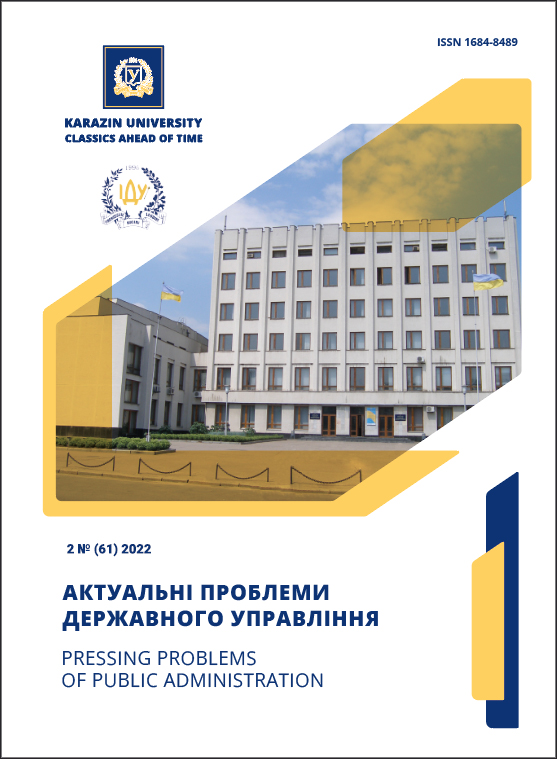Public administration and politics: correlation of theoretical concepts in historical retrospect
Abstract
The article analyzes the classification of the relationship between politics and administration, it was found that four models are distinguished according to the degree of interrelationship: classical, bureaucratic, deliberative, and hybrid. The formation and characteristic features of each model are considered. It was singled out a number of advantages of the hybrid model and given four main reasons that recommend its use: 1) provides an innovative (non-rationalist) view of the political process; 2) integrates policy and administration; 3) is sensitive to the complex nature of public policy; 4) it has the potential to deepen the democratic process.
In modern socio-economic conditions, the Ukrainian system of public administration has not yet found an optimal relationship between politics and administration, there is no clear separation of administrative and political functions. The reality of public administration shows that Ukraine lacks professional administrators-managers, free from the “pressure” of politics, as well as politicians who understand administrative mechanisms. However, the science of public administration was conceived as a technical way of solving social problems, which allows people to avoid the pitfalls of politics. It can be said that society would have better life if the collective decision-making process was devoid of political mediation and instead based solely on scientific approach.
Although even in this case, it is worth remembering that public administration, which is guided by the instrumental type of rationality, does not allow civil society (which is based on the communicative type of rationality) to have a significant impact on administrative activities.
Therefore, in our opinion, the best way to combine such similar and at the same time different phenomena as politics and administration is the method proposed by the hybrid model, because it defines: a) that public administration performs both administrative and political tasks; b) the political process as a continuous dispute that is never resolved forever, the hybrid model is adapted to the increasingly complex conditions of policy formation.
After all, the hybrid model notes the coexistence of several views; it allows political subjects to express their disagreement through political centers. By identifying conflict in the political process, the hybrid model promotes the development of democratic practices and institutions. Dissent, rather than binding consensus, is indispensable for revitalizing democratic processes and eliminating the “democratic deficits” that pervade modern societies.
Downloads
References
Afonin, E.A., Berezhnyi, Ya.V., Valevskyi, O.L. ta in. (2010). Conceptual approaches to interaction of policy and administration; za zah. red. V. A. Rebkala. Kyiv: NADU [in Ukrainian].
Hrushevskyi, M. (1911). Our policy. Lviv. Drukarnia nauk t-va im. T.H. Shevchenka [in Ukrainian].
Dunayv, I.V. (2017). Public regional economic policy in Ukraine: formation of modernization mechanisms. Kharkiv: Magister [in Ukrainian]
Teleshun, S.O., Sytnyk, S.V., Reiterovich, I.V. (2016). The essence of public policy: the context of politics and public administration. URL: http://www.vidkryti-ochi.org.ua/2016/05/blog-post_30.html [in Ukrainian]
Bäcklund, P. and Mäntysalo, R. (2010). Agonism and institutional ambiguity: ideas on democracy and the role of participation in the development of planning theory and practice – the case of Finland. Planning Theory, 9 (4), 333–350.
Deleon, P. (1988). Advice and Consent: The Development of the Policy Sciences. New York: Russell Sage Foundation.
Dunn, W. (1981). Public Policy Analysis: An Introduction. Englewood Cliffs: Prentice-Hall.
Greenberger, M., Crenson, M., Crissey, B. (1976). Models in the Policy Process-Public Decision Making in the Computer Era. New York: Russell Sage Foundation.
Habermas, J. (1996). Between Facts and Norms: Contributions to a Discourse Theory of Law and Democracy, trans. W. Rehg. Cambridge: MIT Press.
Kelly, T. (2004). Unlocking the iron cage: public administration in the deliberative democratic theory of Jürgen Habermas. Administration and Society, 36 (1), 38–61.
Lasswell, H.D. (1956). The Decision Process: Seven Categories of Functional Analysis. College Park: University of Maryland Press.
Lasswell, H.D. (1963). The Future of Political Science. New York: Prentice Hall.
Lee, E. (1995). Political science, public administration, and the rise of the American administrative state. Public Administration Review, 55 (6), 538–546.
Matus, C. Interview with professor Carlos Matus. URL: http://www.youtube.com/watch?v=FNuyqy827wU
Meier, K. (1997). Bureaucracy and democracy: the case for more bureaucracy and less democracy. Public Administration Review, 57 (3), 193–199.
Mouffe, C. (2013). Agonistics: Thinking the World Politically. London: Verso.
Nabatchi, T. (2010). Addressing the citizenship and democratic deficits: the potential of deliberative democracy for public administration. The American Review of Public Administration,
(4), 376–399.
Nabatchi, T., Goerdel, H., and Shelly, P. (2011). Public administration in dark times: some questions for the future of the field. Journal of Public Administration Research and Theory, 21 (Suppl), 29–43.
Ney, S. (2009). Resolving Messy Policy Problems: Handling Conflict in Environmental, Transport, Health and Ageing Policy. London: Earthscan.
Parsons, W. (2005). Public Policy. London: Edward Elgar.
Rosenbloom, D. (1993). Editorial: have an administrative Rx? Don’t forget the politics! Public Administration Review, 53 (6), 503–506.
Sancino, A., Meneguzzo, М., Braga, А., Esposito, Р. (2018). The relationship between politics and administration. URL: https://www.routledgehandbooks.com/doi/10.4324/9781315306278-6
Schön, D. and Rein, M. (1995). Frame Reflection: Toward the Resolution of Intractable Policy Controversies. New York: Basic books.
Sørensen, E. and Torfing, J. (2007). Theoretical approaches to democratic network governance. In E. Sørensen, & J. Torfing (Eds.). Theories of democraric network governance. Basingstoke: Palgrave Macmillan, 233–247.
Tansu, D. (2014). Three Schools, Three Approaches, and Three Suggestions. Politics and Administration, 2, 503–532. DOI: https://doi.org/10.2753/ATP1084-1806310403
Waldo, D. (1948). The Administrative State: A Study of the Political Theory of American Public Administration. New York: Ronald Press.
Weber, M. (1946). Bureaucracy, in H. Gerth and C. Mills (eds). From Max Weber: Essays in Sociology. New York: Oxford University Press, 196–244.
White, L. (1926). Introduction to the Study of Public Administration. New York: Macmillan Company. URL: https://catalogue.nla.gov.au/Record/2478542
Willoughby, W. (1927). Principles of Public Administration with Special Reference to the National and State Governments. Baltimore: John Hopkins Press.
Wilson, W. (1887). The study of administration. Political Science Quarterly, 2 (2), 197–222.

